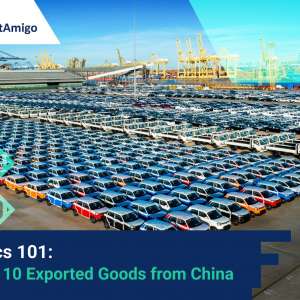Author Name: Tiffany Lee – Marketing Analyst at FreightAmigo
In today’s interconnected global economy, international trade plays a vital role in driving economic growth and development. To facilitate the smooth flow of goods and services across borders, countries often establish Free Trade Agreements (FTAs). These agreements aim to reduce or eliminate trade barriers and promote the liberalization of international trade. By doing so, FTAs create significant opportunities for businesses involved in supply chain management and freight transportation.
Want To Compare The Best Express, Air Freight, Sea Freight, Rail Freight & Trucking Rates So As To Have Better Control On Cost?
Understanding Free Trade Agreements
A Free Trade Agreement is a pact between two or more nations that aims to reduce barriers to imports and exports among them. Under a free trade policy, goods and services can be bought and sold across international borders with little or no government tariffs, quotas, subsidies, or prohibitions to inhibit their exchange. The concept of free trade is the opposite of trade protectionism or economic isolationism.
Why Free Trade Matters
Free trade agreements play a crucial role in promoting economic growth and development. By reducing trade barriers, these agreements foster increased trade volumes and create new business opportunities for companies involved in international trade. Free trade allows businesses to access a broader market, leading to increased sales and revenue. It also encourages specialization and efficiency, as countries can focus on producing goods and services that best utilize their resources and capabilities.
Moreover, free trade benefits consumers by providing access to a wider range of goods at competitive prices. Increased competition drives down prices, allowing consumers to enjoy cost savings and a higher standard of living. Free trade also incentivizes innovation, as companies strive to stay competitive in the global marketplace.
How Free Trade Agreements Work
In the modern world, free trade policies are often implemented through formal and mutual agreements between nations. However, free trade can also be achieved through the absence of trade restrictions, known as “laissez-faire trade” or trade liberalization.
It is important to note that governments with free trade policies or agreements in place still retain some control over imports and exports. Few free trade agreements result in completely unrestricted trade. Nations may have certain exceptions or restrictions in place to protect public health, safety, or specific industries. For instance, a country may restrict the import of drugs not approved by its regulators or ban the import of animals that have not been vaccinated.
The Economics of Free Trade
The concept of free trade was first popularized by economist David Ricardo in his book “On the Principles of Political Economy and Taxation” published in 1817. Ricardo argued that free trade expands the diversity of goods available in a nation while better utilizing its resources, knowledge, and specialized skills. By allowing countries to focus on producing goods where they have a comparative advantage, free trade enables more efficient resource allocation and overall economic growth.
Advantages of Free Trade
The benefits of free trade are numerous and impact various stakeholders, including businesses, consumers, and economies. Let us explore some of the key advantages of free trade.
1. Rapid Development
Free trade has played a significant role in the rapid economic growth of many countries. By focusing on exports and leveraging their comparative advantages, nations can attract foreign investment capital and create high-paying jobs for their citizens. This increased economic activity contributes to overall development and prosperity.
2. Lower Global Prices
For consumers, free trade creates a competitive environment where countries strive to provide the lowest possible prices for their resources and finished goods. This competition drives down prices, increasing the buying power of consumers and improving their overall standard of living.
3. Access to a Wide Range of Goods
Free trade allows consumers to access a broader range of goods and services from around the world. By eliminating trade barriers, countries can import products that may not be locally available or are more cost-effective to produce in other regions. This leads to greater consumer choice and availability of diverse products
4. Increased Efficiency and Specialization
Free trade encourages countries to specialize in producing goods and services that align with their comparative advantages. This specialization leads to increased efficiency and productivity, as resources can be allocated more effectively. By focusing on what they do best, countries can achieve higher levels of output and economic growth.
Disadvantages of Free Trade
While free trade offers several advantages, it is not without its challenges and criticisms. Let us explore some of the key disadvantages associated with free trade.
1. Unemployment and Business Losses
One of the main concerns regarding free trade is the potential impact on domestic industries and employment. When countries open their borders to free trade, domestic industries may struggle to compete with foreign competitors, leading to job losses and business closures. Sectors that face intense competition from imports may experience significant challenges, potentially resulting in unemployment and economic dislocation.
2. Environmental and Labor Concerns
Another criticism of free trade is that it may lead to the relocation of industries to countries with lax environmental and labor regulations. This can result in environmental damage, exploitation of workers, and the erosion of labor standards. Critics argue that free trade should be accompanied by measures to ensure fair labor practices and environmental sustainability.
3. Dependency on the Global Market
While free trade can offer access to cheaper goods on the world market, it can also make countries more dependent on imports. This dependency can create vulnerabilities, especially during times of crisis or geopolitical tensions. In such situations, countries that rely heavily on imports may face challenges in securing essential goods and may need to rebuild industries from scratch.
Real-World Examples of Free Trade Agreements
Free trade agreements are prevalent worldwide, with numerous examples showcasing their impact on international trade. Let us explore some notable examples of free trade agreements:
1. European Union (EU)
The European Union is a prime example of a free trade area. Member nations form an essentially borderless single entity for trade purposes, with the goal of promoting economic integration and collaboration. The adoption of the euro as a common currency further facilitates trade within the EU. However, it is important to note that this system is regulated by a bureaucracy based in Brussels, which manages trade-related issues between member nations.
2. United States Free Trade Agreements
The United States has several free trade agreements in place, including the North American Free Trade Agreement (NAFTA) covering the U.S., Canada, and Mexico, and the Central American Free Trade Agreement (CAFTA) encompassing most nations in Central America. Additionally, the U.S. has separate trade agreements with countries ranging from Australia to Peru. These agreements have significantly influenced trade patterns and market access for businesses operating in these regions.
3. Hong Kong Free Trade Agreement
As an international trade center, Hong Kong has signed free trade agreements with many countries and regions. These include the Mainland-Hong Kong Closer Economic Partnership Arrangement (CEPA) with Mainland China, and free trade agreements with Singapore, Australia, New Zealand and others. These agreements provide enterprises in Hong Kong with easier market access, lower tariffs and trade barriers, and promote the free flow of trade and investment.
Unlocking Opportunities: How FreightAmigo Facilitates Free Trade Agreement Utilization
FreightAmigo offers valuable support to businesses looking to take advantage of Free Trade Agreements. With their expertise in supply chain and international trade, they provide services such as cross-border logistics solutions, customs affairs management, and access to a global transportation network. By leveraging these services, businesses can navigate the complexities of international trade, streamline their supply chains, and benefit from the advantages offered by Free Trade Agreements. FreightAmigo’s assistance helps businesses optimize their international trade operations and enhance their competitiveness in the global marketplace.
There Are Different Options For Cargo Transportation. If You Want To Choose The Most Convenient And Suitable Solution, It Is Best To Have The Full Support Of Logistics Experts! If You Are Planning To Ship Goods Overseas, Please Go To The FreightAmigo Page For Inquiries.
===
Read More:
【Trade News】US Eases Tariff on UK Steel and Aluminum Exports
Green Logistics: Reducing Carbon Footprint in Supply Chains
===
If you have any inquiries on logistics/supply chain, feel free to contact FreightAmigo now:
Chat with us online OR
Phone : +852 28121686
WhatsApp: +852 27467829









































